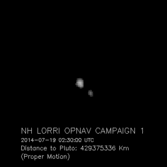General Discussion
Related: Editorials & Other Articles, Issue Forums, Alliance Forums, Region ForumsNew Horizons wake up - On Pluto's Doorstep
On Saturday, Dec. 6, New Horizons will awaken from its final segment of hibernation on its historic, 3-billion-plus mile cruise from Earth to Pluto.
“The final hibernation wake up Dec. 6 signifies the end of an historic cruise across the entirety of our planetary system” - New Horizons Principal Investigator Alan Stern, of the Southwest Research Institute. “We are almost on Pluto’s doorstep!”
The Johns Hopkins Applied Physics Laboratory manages the New Horizons mission for NASA’s Science Mission Directorate. Alan Stern, of the Southwest Research Institute (SwRI) is the principal investigator and leads the mission; SwRI leads the science team, payload operations, and encounter science planning. New Horizons is part of the New Frontiers Program managed by NASA's Marshall Space Flight Center in Huntsville, Ala. APL designed, built and operates the New Horizons spacecraft.
http://pluto.jhuapl.edu/
Help the New Horizons team pick a wake-up image

vote here:
http://www.alexharrisonparker.com/plutopoll/#Poll

New Horizons images shows Jupiter and its volcanic moon Io, and were taken during the spacecraft's Jupiter flyby in early 2007. The image of Jupiter is an infrared color composite taken by the spacecraft's near-infrared imaging spectrometer, the Linear Etalon Imaging Spectral Array. The infrared wavelengths used highlight variations in the altitude of the Jovian cloud tops, with blue denoting high-altitude clouds and hazes, and red indicating deeper clouds. The prominent bluish-white oval is the Great Red Spot.
Fred Sanders
(23,946 posts)Baclava
(12,047 posts)Last edited Fri Dec 5, 2014, 09:58 PM - Edit history (3)
I just hope we get some good pics


BlueJazz
(25,348 posts)As far as the image:
.
. 
opiate69
(10,129 posts)BlueJazz
(25,348 posts)Baclava
(12,047 posts)just hope it wakes up
Glassunion
(10,201 posts)Had it for a few years now.
Right now the craft is 31.93 AU from Earth, 1.76 AU from Pluto. It would take light about 9 hours to round trip from here to the craft.
220 days, 15h, 5m, 18s to the closest approach at its current speed. That would take 14m at the speed of light, almost 14 years in the Concorde, 337 years by car, or about 6,000 years walking.
It recently crossed the orbital distance of Neptune.
On that photo of Jupiter and Io you can see at Io's pole, light reflecting off of material erupting from the Tvashtar volcano.
Baclava
(12,047 posts)Baclava
(12,047 posts)Glassunion
(10,201 posts)True Blue Door
(2,969 posts)Three if you count Charon, which New Horizons will probably get good shots of.
I'm personally more excited about Ceres because it's close enough to be within the realm of possibility that humans will visit it in my lifetime.
Baclava
(12,047 posts)That would be my ideal asteroid destination for setting up a colony.
The Dawn Spacecraft Is Closing in on Dwarf Planet Ceres
Dawn will be captured into Ceres' orbit in March, marking the first visit to a dwarf planet by a spacecraft.
Dwarf planet Ceres may have more fresh water than Earth
Astronomers using the Herschel Space Observatory have made the first definitive detection of a thin water-vapour atmosphere surrounding Ceres, and if their estimations are correct, the dwarf planet may have more fresh water than we have on Earth.

For the past few years, scientists have been taking a careful look at Ceres, which orbits the sun between Mars and Jupiter in our solar system's asteroid belt. Given its size and shape — nearly 500 kilometres across and the roundest object in the asteroid belt — there's been speculation that Ceres may be similar to other bodies, like Jupiter's Europa and Saturn's Enceladus, with a rocky core surrounded by a thick mantle of ice.
Now, by using Herschel's infrared cameras, astronomers have spotted plumes of water vapour from the surface of Ceres, confirming the speculations about the dwarf planet's composition.
"This is the first time water vapor has been unequivocally detected on Ceres or any other object in the asteroid belt and provides proof that Ceres has an icy surface and an atmosphere," said Michael Küppers, the study lead author, according to NASA.
https://ca.news.yahoo.com/blogs/geekquinox/dwarf-planet-ceres-may-more-fresh-water-earth-185607028.html
Largest Asteroid May Be 'Mini Planet' with Water Ice
/
http://hubblesite.org/newscenter/archive/releases/2005/27/image/a/
http://dawn.jpl.nasa.gov/feature_stories/Dawn_snaps_image_Ceres.asp
Posteritatis
(18,807 posts)Odin2005
(53,521 posts)I can see it in the future becoming a powerful, wealthy city state, and interplanetary Venice, getting rich off of mining nearby asteroids.
True Blue Door
(2,969 posts)A dynamic, highly mobile culture.
Octafish
(55,745 posts)Thanks for the heads-up, Baclava!
Baclava
(12,047 posts)Then, at 5 p.m. ET, New Horizons will send a simple confirmation message to scientists at the Applied Physics Laboratory at Johns Hopkins University.
Moving at the speed of light, the message will take four hours and 25 minutes to travel all the way back to Earth.

http://pluto.jhuapl.edu/mission/whereis_nh.php
Octafish
(55,745 posts)Baclava
(12,047 posts)NASA
It's ALIVE! The @NASANewHorizons mission control just received full confirmation at 9:53 p.m ET! Pluto get ready!
It took 4 hours and 25 minutes for the signal to cover 4.7 billion kilometers and reach the mission operations team at Applied Physics Laboratory at Johns Hopkins University

